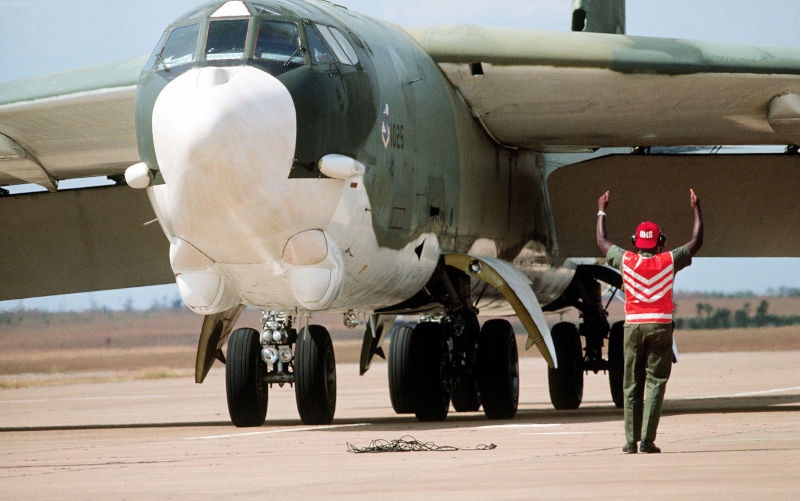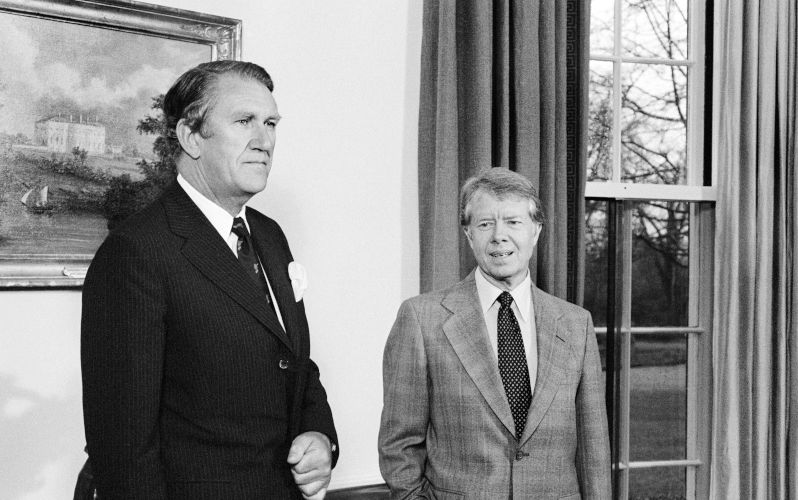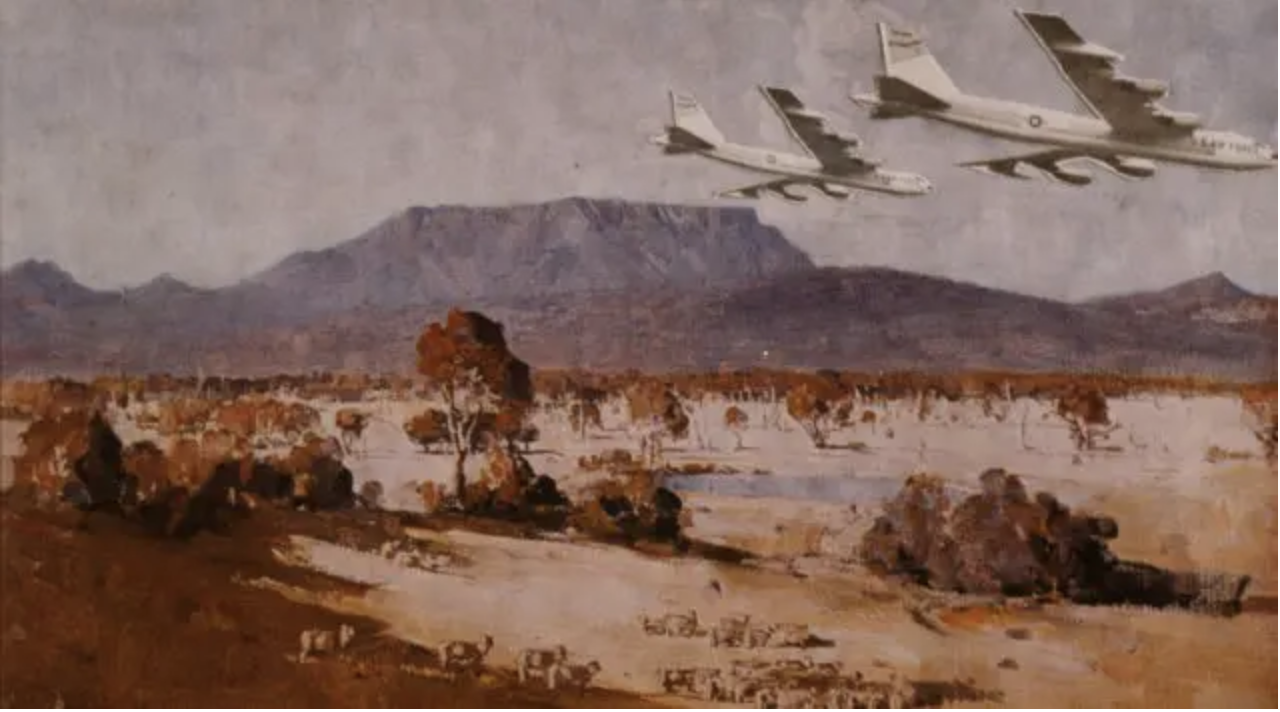When Australia defied US nuclear plans. Part 2: Sovereignty at stake
September 7, 2025
Declassified US. Pacific Command Histories, which provide much of what is now known about the Australian B-52 terrain avoidance and maritime surveillance missions, reveal that the Fraser Government was far from transparent with the public about the true stakes of the B-52 deployments to Australia – and perhaps not fully cognisant itself.
Internal cabinet deliberations, however, tell a different story. They reveal the risks, the uncertainties and the trade-offs Australia faced as it sought to negotiate the final terms of both missions with Washington.
On 29 July 1980, defence minister Jim Killen delivered to the Foreign Affairs and Defence Committee the most detailed, candid and influential assessment of the issues.
Killen’s submission endorsed the B-52 deployment as a way of “demonstrating disapproval” of the Soviet invasion of Afghanistan and deterring further expansion. But the real deterrent, it was explained, lay not in the aircraft themselves but in what they symbolised – a tripwire that could trigger nuclear escalation.
Militarily, the operations were judged “essentially token”, as America’s wider B-52 deployments to the region would occur regardless of Australia’s support. Diplomatically, however, the agreement was viewed as enhancing Australia’s standing as a “worthwhile ally”, improving “access to, though not necessarily influence on”, American policy making.
Beyond the shared objective of deterring the Soviet Union, Killen’s submission cautioned that B-52s deployed to Australia might serve broader US aims, noting that the “practical focus” of American operations would likely be on other regional issues. Potential scenarios ranged from intervening in domestic politics for the purpose of “preserving co-operative regimes” to “occupy[ing] an oil-producing state’s territory” to secure Middle Eastern oilfields.
The submission also questioned the soundness of US policy methods, warning in unusually frank terms that “undue US reliance on military force” could “make situations worse” – a subtle critique of American militarism, likely informed by memories of the Vietnam War.
Yet, amid all this analysis, the submission acknowledged a fundamental uncertainty: “We do not know in what operations and with what objectives U.S forces using Australian facilities might be used.”
A particularly striking passage candidly acknowledged that Australia was unlikely to always agree with US policy, or wish to be practically associated with it, and warned that departing from past defence policy by accepting the regular staging of US forces could undermine Australian sovereignty:
“The US would certainly not accept that its military operations, where supported by our facilities, should be subject to the approval of the Australian Government from day to day.
“The Australian Government could not assume that it could exercise influence to modify US policies where major US interests were seen to be at stake, let alone have them abandoned.
“The operation of US military units from Australian territory could, therefore, involve a reduction of national control over Australia’s international involvements.”
In short, while Defence was unusually candid about the risks, uncertainties and trade-offs associated with hosting its key security ally, it ultimately endorsed stationing the world’s most powerful nuclear-capable military on Australian soil – conceding it could neither fully know nor dictate its aims, nor control the consequences.

Just weeks later, on 14 August 1980, Killen returned with a second submission, this time confronting the nuclear question head-on. US policy to neither confirm nor deny the presence of nuclear weapons on its ships and aircraft was acknowledged, yet the submission insisted:
“It will be important to sustain the position proposed by the Defence Committee, that unless there is specific agreement to the contrary, US use of facilities in Australia should not include the introduction of nuclear weapons.”
Killen’s assessments, including the Defence Committee’s firm stance on the nuclear question, carried through to Fraser’s negotiating stance with Washington and, ultimately, the final agreement.
In defiance of neither confirm nor deny: ‘They will tell me’
After almost a year of intense, highly sensitive negotiations in the last year of the Carter Administration and the opening months of the Reagan’s presidency, Fraser delivered his 11 March 1981 Ministerial Statement to parliament.
The statement included texts of the notes exchanged between Australia and the US that together constituted the treaty-level 1981 Staging Agreement between both countries.
It was in summarising the agreement that Fraser made his landmark declaration: B-52 bombers deployed to Australia would be “unarmed and will carry no bombs”.
This assurance was codified in an “agreed form of words exchanged” between foreign minister Paul Street and US secretary of state Alexander Haig, inspected by the leader of the Opposition, Bill Hayden, and held “in the keeping of the Australian Embassy in Washington”.
Hayden, however, was unconvinced, correctly noting that Washington had refused to offer such assurances to other allies: “the document has absolutely no standing”.
His scepticism proved unfounded.
Two week later, the US embassy in Canberra released a statement, approved by Washington, that reaffirmed the assurance without qualification. Fraser incorporated the statement in Hansard on 2 April:
“QUESTION: Will these aircraft be armed?”
“ANSWER: As the prime minister announced in Canberra, 11 March, these aircraft will be unarmed and carry no bombs.”
Declassified U.S Pacific Command Histories later confirmed that the Australian Defence Department had agreed to the BUSY BOOMERANG and GLAD CUSTOMER missions “on the understanding that the B-52 aircraft taking part would be ‘unarmed and not carry bombs’.” This was, the histories noted, “contrary to the standard worldwide US practice of neither confirming nor denying the presence of nuclear weapons”. However,
“as a result of the intensive negotiations the two governments had agreed in 1980 that the Australians could use the ‘unarmed-and-carry-no-bombs’ phrase, and Australian approval was conditional on reaching agreement on this issue.”
When questioned about whether the United States would withhold such information from Australia, Fraser, characteristically adamant, replied: ‘They will tell me’.
And clearly the United States did so, to its chagrin.

Fraser’s nuclear heterodoxy
There were several dimensions to Fraser’s nuclear heterodoxy.
Beyond his key announcement that the bombers must be unarmed, Fraser insisted that “the agreement of the Australian Government would need to be obtained before the facilities at RAAF Base, Darwin, could be used in support of any other category of operations”.
Remarkably, in contrast to the practices of later Australian Governments, Fraser outlined “the basis on which the agreement of the Australian Government would be given to such other operations” in terms that were considerably more public, explicit and robust than those found in later agreements with the United States concerning nuclear-capable aircraft – most notably the 2014 United States Force Posture Agreement and related accords.
Fraser made clear:
“Australia would need to know, firstly, what the strategic and tactical objectives are — Australia would need to be in agreement with these — and, secondly, what weapons are being carried and in particular whether nuclear weapons are being carried.”
Even more striking, given both the historical and current contexts of the US policy to neither confirm nor deny the presence of nuclear weapons, he added:
“The Australian Government has a firm policy that aircraft carrying nuclear weapons will not be allowed to fly over or stage through Australia without its prior knowledge and agreement.”
Additionally, Fraser insisted on a degree of democratic transparency and accountability concerning war powers when he declared that should his government accept any future US request for other B-52 operations, including nuclear operations, the House would be informed and provided with the opportunity to debate the agreement:
“I also indicate to the House that if the agreement of the Government of Australia were sought and given for any other category of operations I, or the minister, would advise the House at the time of its being done. The Parliament would be able to debate that agreement if it wished to do so.”
This heterodox rejection of the neither confirm nor deny policy was articulated explicitly within the framework of protecting Australian sovereignty: “Nothing less than this is or would be consistent with the maintenance of our national sovereignty.”
It is important to note that Fraser treated visiting US ships and submarines differently from B-52 operations because, rightly or wrongly, he viewed their implications for sovereignty as markedly different.
Ships docking for rest and replenishment posed minimal sovereignty risks, Fraser argued, as they did not use Australian territory to launch specific missions, including nuclear missions, against a foreign target. B-52s, however, staged from Australian soil, and Fraser insisted that denying the government knowledge or consent over their objectives would be, in his words, “a derogation of Australia’s sovereignty”.
Unprecedented and never repeated
During the 1980s dozens of countries, including NATO allies, had policies excluding nuclear weapons from home soil and in territorial waters. However, few of these nominal bans prevented the entry of nuclear-armed ships or aircraft.
The United States and its ostensibly nuclear-free allies, such as Norway, Denmark and Japan, relied on what US defence secretary Robert McNamara once described as “tacit understandings” and Norwegian defence minister Johan Jørgen Holst termed a “double qualification”: the host nation maintains the qualification that foreign naval vessels must not carry nuclear weapons, and visiting nuclear-allied states adhere to the qualification of neither confirm nor deny – ensuring that the nuclear question was never formally raised.
The result was polite fiction: the host nation publicly assumed compliance, while privately accepting that non-compliance was all but assured.
Australia under Malcolm Fraser was the lone exception. Unlike any other US-allied host of nuclear-capable platforms, Canberra not only enforced a national prohibition on nuclear-capable aircraft, it prised from Washington a rare and explicit public exemption from its neither confirm nor deny policy.
This practice was unprecedented and never repeated by any host government of US nuclear-capable platforms, in Australia or elsewhere.
The fate of Fraser’s nuclear heterodoxy
In 1981, Malcolm Fraser established a high-water mark for Australian sovereignty over US nuclear-capable bomber operations. By contrast, today’s 2014 Force Posture Agreement, which governs the full spectrum of US force posture deployments to Australia — including strategic bombers — represents a stark departure.
The 2014 FPA grants US forces expanded access to a substantial — but classified — number of Australian facilities and areas, with limited transparency over the scope of operations. Under its terms, activities undertaken by US forces can involve any category “as the Parties may mutually determine”, leaving much of their nature shrouded in ambiguity.
Critically, unlike Fraser’s framework, the FPA does not require explicit assurances of prior knowledge or agreement before US forces can deploy nuclear weapons. Consultation mechanisms stipulate that “relevant mutually determined activities are conducted in accordance with Australia’s policy of Full Knowledge and Concurrence”, but this requirement applies only “where applicable”.
The government’s policy of Full Knowledge and Concurrence — the stated right to know, understand, and agree to foreign military activities — is difficult to reconcile with the willed ignorance that flows from its commitment to “understand and respect” the US policy of neither confirming nor denying the presence of nuclear weapons.
This tension is no longer theoretical. RAAF Tindal, near Katherine, is slated to host up to six forward-deployed B-52 bombers, complete with infrastructure enabling sustained strategic combat operations from Australian soil – including potential nuclear missions.
The dismantling of Fraser’s strict policy safeguards on the introduction of nuclear weapons now carries consequences more profound and immediate than at any point in Australia’s history.
While the South Pacific Nuclear Free Zone Treaty, to which Australia is a party, prohibits the “stationing” of nuclear weapons, it allows parties to decide for themselves whether or not to allow “transits” or “visits” by nuclear-armed vessels and aircraft. With Fraser’s safeguards removed, there are now no clear legal or policy barriers to such deployments.
By abandoning Fraser’s nuclear heterodoxy, Australia has accepted a level of strategic ambiguity it once worked hard to avoid – potentially opening the door to nuclear operations whose scope and consequences may ultimately be determined elsewhere.
[This article draws on Vince Scappatura and Richard Tanter, B-52 strategic bombers in Australia 1979 – 1991 and the nuclear heterodoxy of Malcolm Fraser, Nautilus Institute Special Report, 4 August 2025. It follows the authors’ Nuclear-capable B-52H Stratofortress strategic bombers: a visual guide to identification, Nautilus Institute Special Report, 26 August 2024.]
Republished from Declassified Australia, 26 August 2025
The views expressed in this article may or may not reflect those of Pearls and Irritations.
